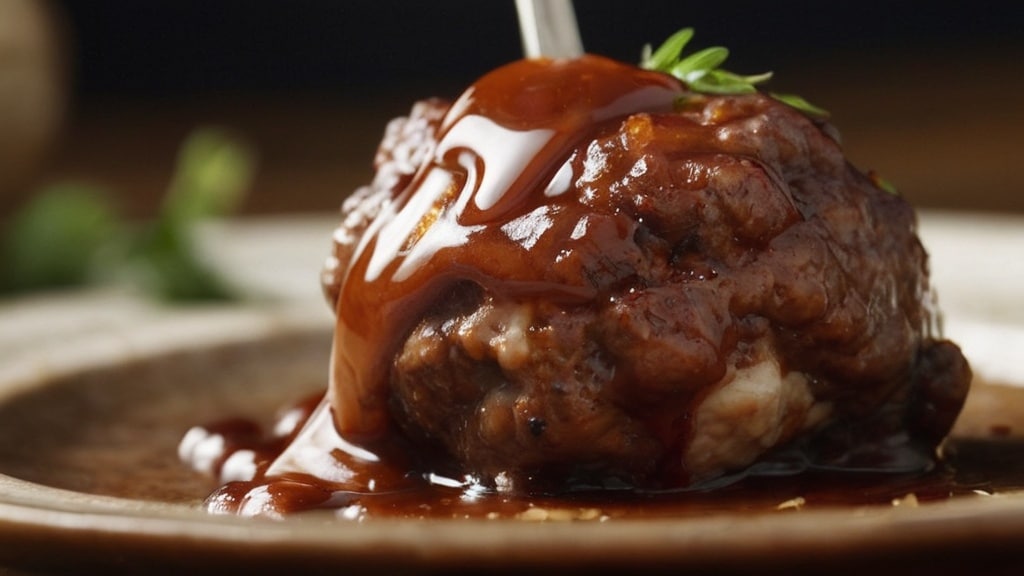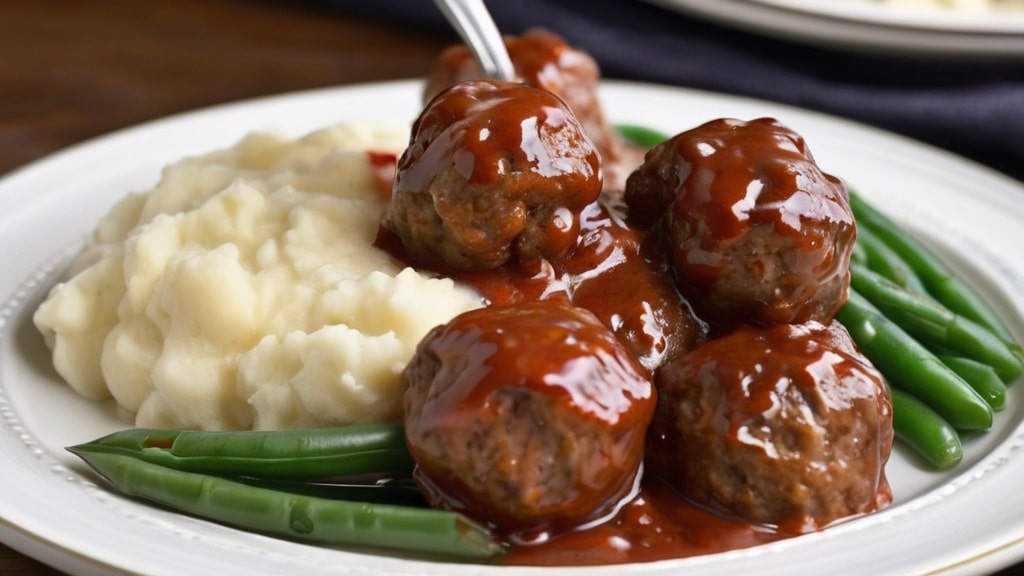Have you ever watched a platter of appetizers disappear in minutes flat, with guests hovering nearby hoping for just one more taste? That’s precisly what happens whenever I bring out my barbecue meatballs at gatherings. The first time I served these little flavor bombs at a neighborhood block party, they vanished so quickly that I barely managed to snag one for myself and I’ve been doubling the recipe ever since.
These sweet and smoky barbecue meatballs represent the perfect intersection of convenience and culinary magic. Unlike traditional meatball recipes that often require extensive prep and multiple cooking stages, this approach streamlines the process without sacrificing an ounce of flavor. What makes these meatballs truly special is their complex flavor profile the perfect balance of sweet, smoky, tangy, and savory elements that create an addictive quality that keeps people coming back for “just one more.” The technique of simmering the meatballs directly in the sauce infuses them with flavor while maintaining a tender, juicy texture that frozen or pre-cooked alternatives simply cannot match.
Ingredients & Substitutions

For the Meatballs
- 1 pound ground beef (80/20 lean-to-fat ratio)
- 1/2 pound ground pork
- 1/2 cup panko breadcrumbs
- 1/3 cup finely grated onion (with juice)
- 2 large eggs, lightly beaten
- 3 garlic cloves, minced
- 2 tablespoons worcestershire sauce
- 1 tablespoon smoked paprika
- 1 teaspoon salt
- 1/2 teaspoon freshly ground black pepper
- 2 tablespoons vegetable oil (for browning)
For the Sweet and Smoky Sauce
- 1 1/2 cups ketchup
- 1/2 cup packed dark brown sugar
- 1/4 cup molasses
- 3 tablespoons apple cider vinegar
- 2 tablespoons worcestershire sauce
- 2 tablespoons dijon mustard
- 1 tablespoon liquid smoke (hickory or mesquite)
- 2 teaspoons garlic powder
- 1 teaspoon onion powder
- 1/2 teaspoon cayenne pepper (optional)
- 1/4 cup bourbon whiskey (optional)
For those managing dietary restrictions, several thoughtful substitutions can maintain the integrity of this recipe. Ground turkey can replace beef and pork for a lighter option, though you’ll wanna add 2 tablespoons of olive oil to the mixture to compensate for the reduced fat content. Gluten-sensitive eaters can swap the panko for crushed Rice Chex or certified gluten-free breadcrumbs. The eggs function primarily as a binder—a mixture of 2 tablespoons ground flaxseed combined with 6 tablespoons warm water (allow to sit for 5 minutes before using) makes an excellent plant-based alternative.
The choice of ground meat significantly impacts the final texture and flavor profile of these meatballs. The 80/20 beef provides essential fat that renders during cooking, creating pockets of juiciness throughout. Ground pork contributes a milder flavor and more tender texture than beef alone could achieve. Pre-packaged “meatloaf mix” (combining beef, pork, and veal) makes a luxurious substitute if available. Whichever meat you select, avoid overhandling during mixing, which compacts proteins and results in dense, tough meatballs rather than the tender, juicy spheres we’re aiming for.
Step-by-Step Instructions
Preparing the Meatball Mixture
- In a large mixing bowl, combine the ground beef, pork, breadcrumbs, grated onion (with its flavorful juice), beaten eggs, minced garlic, worcestershire sauce, smoked paprika, salt, and pepper. Many cooks make the cardinal mistake of overworking the mixture—use your hands to gently fold ingredients together just until combined, stopping the moment the ingredients are evenly distributed. Imagine your touching a newborn kitten; that’s how gentle your hands should be.
- Cover the mixture and refrigerate for at least 30 minutes, ideally an hour. This resting period allows the breadcrumbs to fully hydrate and the proteins to relax, resulting in a more cohesive mixture that forms easily and maintains its shape during cooking. If your rushed for time (aren’t we all sometimes?), place the mixture in the freezer for 15 minutes instead.
- With lightly dampened hands (this prevents sticking), portion the mixture into meatballs approximately 1 1/2 inches in diameter—about the size of a golf ball. A medium cookie scoop or ice cream scoop provides consistent sizing, ensuring even cooking. For appetizer portions, form smaller 1-inch meatballs, adjusting cooking time accordingly. Arrange the formed meatballs on a parchment-lined baking sheet, leaving a small space between each one.
Browning and Sauce Preparation
- Heat the vegetable oil in a large, deep skillet or Dutch oven over medium-high heat until shimmering but not smoking. Working in batches to avoid crowding, brown the meatballs on all sides—approximately 1-2 minutes per side. The goal here isn’t to cook them through but to develop a flavorful crust through the Maillard reaction. Overcrowding the pan causes the meatballs to steam rather than brown, robbing you of crucial flavor development.
- While the meatballs brown, prepare the sauce by combining ketchup, dark brown sugar, molasses, apple cider vinegar, worcestershire sauce, dijon mustard, liquid smoke, garlic powder, onion powder, and cayenne (if using) in a medium bowl. Whisk until smooth and fully incorporated. If your including bourbon, add it now—the alcohol will cook off during simmering, leaving behind complex caramel and vanilla notes that complement the smoky elements beautifully.
- Once all meatballs have been browned, drain excess fat from the pan, leaving about 1 tablespoon behind. Return all meatballs to the pan and pour the sauce over them, gently turning to coat each one. Bring the sauce to a simmer, then reduce heat to low, cover, and cook for 15-20 minutes, occasionally turning the meatballs, until they reach an internal temperature of 160°F and the sauce has thickened slightly. For an intense flavor infusion, consider transferring the covered pan to a 325°F oven for 30 minutes instead of stovetop simmering.
Variations to Explore
For a spicier version that still maintains balance, add 1-2 tablespoons of your favorite hot sauce or 1 teaspoon of chipotle powder to the sauce mixture. Craving something more exotic? Incorporate 2 tablespoons of gochujang (Korean chili paste) and 1 tablespoon of honey for a Korean-inspired twist with addictive heat and depth. Looking for a fruity dimension? Substitute half the ketchup with pineapple or mango preserves for a tropical variation that works brilliantly for summer gatherings.
Cooking Techniques & Science
The multi-stage cooking approach used in these barbecue meatballs leverages several scientific principles to maximize flavor and texture. Initial browning triggers the Maillard reaction—a complex chemical interaction between amino acids and reducing sugars that creates hundreds of new flavor compounds and that distinctive savory quality we recognize as “browned” food. This reaction occurs optimally between 280°F and 330°F; any cooler and browning happens too slowly, any hotter and you risk burning.
Following the browning stage, the slow simmer in sauce accomplishes two crucial functions. First, it gently brings the meatballs to a safe internal temperature without toughening the proteins. Second, it facilitates flavor exchange between the sauce and meat through osmosis—sauce flavors migrate into the meatballs while meat juices enrich the sauce. The slightly acidic nature of the sauce (from vinegar, ketchup, and mustard) helps break down collagen in the meat, contributing to a more tender final texture.
The combination of both breadcrumbs and eggs creates an internal scaffolding system that traps moisture while providing structure. Without this pairing, meatballs tend toward either crumbling (too little binder) or bouncy toughness (too much protein crosslinking). The panko specifically absorbs liquid without becoming pasty, maintaining proper texture throughout cooking.
Temperature monitoring transforms meatball-making from guesswork to precision cooking. An instant-read digital thermometer inserted into the center of a meatball should register 160°F for beef/pork combinations, ensuring food safety while preventing overcooking. For those without a thermometer, cut one meatball in half—it should be just cooked through with no pink remaining, but still juicy and tender.
Serving & Pairing Suggestions

These versatile barbecue meatballs transition effortlessly between appetizer and main course presentations. For elegant appetizer service, skewer individual meatballs with decorative picks and arrange them around a small bowl of additional warmed sauce for dipping. Garnish with finely sliced green onions cut on a sharp bias, or a light dusting of toasted sesame seeds for visual appeal and textural contrast.
As a hearty main dish, nestle the meatballs and sauce over creamy mashed potatoes, buttered egg noodles, or steamed jasmine rice to catch every drop of the succulent sauce. A simple side of quickly blanched bright green vegetables—like broccolini or sugar snap peas—provides the perfect color contrast and textural counterpoint to the rich meatballs.
The sweet-smoky profile of these meatballs pairs beautifully with beverages that offer complementary or contrasting notes. A malty amber ale or porter echoes the caramel undertones in the sauce, while crisp hard cider provides refreshing contrast. For wine enthusiasts, a fruit-forward Zinfandel or Shiraz stands up nicely to the bold flavors. Non-alcoholic options include spiced apple cider served warm or cold, or a tart lemonade with a splash of unsweetened cranberry juice.
For buffet-style service, transfer the finished meatballs to a slow cooker set to warm. This maintains perfect serving temperature for hours without overcooking—ideal for game day gatherings or potluck situations where timing is unpredictable. Provide small plates and forks rather than toothpicks for this saucy delight; your guests’ dry-cleaning bills will thank you.
Conclusion
The true beauty of these sweet and smoky barbecue meatballs lies in their remarkable versatility and crowd-pleasing profile. They embody that rare culinary achievement—sophistication and complexity accessible through straightforward technique and readily available ingredients. While the recipe as written creates a balanced flavor profile that appeals to most palates, don’t hesitate to adjust the sweet-smoky-tangy equation to suit your personal preference or the specific occasion.
The principles at work in this recipe translate beautifully across culinary applications. The technique of pre-browning followed by sauce-simmering works equally well for larger meatballs, meatloaf, or even braised larger cuts of meat. The sauce itself becomes a valuable addition to your repertoire, working beautifully as a glaze for grilled chicken or ribs, or as a finishing sauce for pulled pork.
Remember that patience represents the secret ingredient in exceptional meatballs. Allow time for the meat mixture to rest before forming, handle it gently during shaping, brown in batches rather than crowding, and simmer slowly to completion. These small disciplines make the difference between good and transcendent results. With practice, you’ll develop an intuitive sense of meatball perfection—that perfect internal temperature, sauce consistency, and flavor balance that transforms a simple appetizer into a signature dish worth sharing and savoring.
FAQs
Can I make these meatballs ahead of time?
Absolutely! In fact, these meatballs benefit from make-ahead preparation in several ways. The uncooked meatball mixture can be refrigerated for up to 24 hours, allowing flavors to meld beautifully before forming and cooking. Alternatively, form the raw meatballs, arrange them on a parchment-lined sheet, and freeze until solid before transferring to freezer bags for storage up to 3 months. No need to thaw before cooking—simply add 5-7 minutes to the browning time. Fully cooked meatballs in sauce keep wonderfully in the refrigerator for 3-4 days and actually improve in flavor as they rest. Reheat gently on the stovetop or in a 325°F oven until warmed through.
Why are my meatballs tough instead of tender?
Several factors contribute to tough meatballs. The most common culprit is overworking the meat mixture during preparation, which causes proteins to cross-link too densely. Mix ingredients just until combined, using a gentle folding motion rather than aggressive kneading. Another possibility is using meat that’s too lean—the fat content in 80/20 beef and pork provides necessary moisture and tenderness. Finally, overcooking leads to moisture loss and toughness; use a thermometer to confirm doneness at precisely 160°F, particularly when making larger meatballs that require longer cooking times. If you consistently struggle with tenderness, try adding 2 tablespoons of ricotta cheese to your mixture—it introduces additional moisture that remains stable during cooking.
Can I bake these meatballs instead of pan-browning them?
While pan-browning delivers optimal flavor development, oven-baking offers a convenient hands-off alternative with good results. Arrange formed meatballs on a parchment-lined baking sheet and bake at 400°F for 10-12 minutes until browned but not fully cooked through. Transfer to your sauce and continue with the simmering step as directed. For enhanced browning in the oven, brush the meatballs lightly with vegetable oil before baking and consider using a sheet pan with low sides rather than a high-sided roasting pan, which traps steam and inhibits browning. The texture will be slightly different—a bit less crusty on the exterior—but the convenience may outweigh this minor difference, especially when preparing large batches.
How can I adapt this recipe for a slow cooker?
This recipe transitions beautifully to a slow cooker with minor adjustments. Complete the browning step as directed, then transfer the meatballs to a 6-quart slow cooker. Mix the sauce ingredients in a separate bowl, then pour over the meatballs. Cook on low for 4-5 hours or on high for 2-3 hours. The slow cooker excels at gentle, moist heat—perfect for keeping meatballs tender. For best results, avoid lifting the lid during cooking, which releases accumulated heat and extends cooking time. If the sauce seems too thin after cooking (due to moisture released from the meatballs), transfer it to a saucepan and simmer uncovered for 5-10 minutes to reach desired consistency, then pour back over the meatballs before serving.
What’s the best way to achieve a perfectly round shape?
Achieving that professional, perfectly spherical meatball involves several techniques. First, ensure your meat mixture is properly chilled before forming—warm meat becomes sticky and difficult to shape cleanly. Use an ice cream or cookie scoop for consistent portioning, then roll each portion between lightly dampened palms using gentle pressure. If meatballs lose their shape during browning, they may be too warm or too loosely packed; returning the formed meatballs to the refrigerator for 15 minutes before cooking helps them maintain their shape during the browning process. Finally, avoid the temptation to constantly flip or move the meatballs during initial browning—allow them to develop a proper crust on one side before carefully turning to another face. With practice, you’ll develop the touch for creating picture-perfect meatballs that cook evenly and present beautifully.

